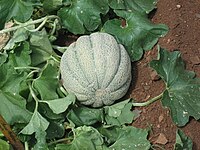
Photo from wikipedia
Benincasa hispida (Thunb.) Cogn. (syn. B. cerifera Savi, Cucurbita hispida Thunb.), called wax gourd or ash gourd, is a cucurbitaceous vine grown for medicinal purposes and commercial values of its… Click to show full abstract
Benincasa hispida (Thunb.) Cogn. (syn. B. cerifera Savi, Cucurbita hispida Thunb.), called wax gourd or ash gourd, is a cucurbitaceous vine grown for medicinal purposes and commercial values of its large fruits in Southeast Asia (Al-Snafi 2013). During the summer and autumn of 2020, leaves of wax gourd were observed to be affected by powdery mildew with 100% disease incidence in an experimental plot of Jeonbuk National University (35°50'55″N, 127°07'48″E), Korea. Fungal colonies were initially circular to irregular, forming white patches on both sides of the leaves and young stems, finally covering entire leaves and causing premature senescence of the leaves and poor growth. A representative voucher specimen was deposited in the Korea University herbarium (KUS-F32171). At least 30 measurements were taken for each asexual diagnostic features. Conidiophores arising from superficial hyphae were straight, 100 to 210 μm long, and produced 3 to 7 immature conidia in chains with a crenate outline. Foot-cells were cylindrical, 46 to 74 ×10 to 12 μm, followed by 1 to 2 shorter cells. Conidia were ellipsoid-ovoid to barrel-shaped, 30 to 40 × 18 to 23 μm with a length/width ratio of 1.4 to 2.0 and contained conspicuous fibrosin bodies. Germ tubes were produced from a lateral position on conidia. Sexual stage was not observed during the growing season. The morphological characteristics of the fungus were compatible with those of Podosphaera xanthii (Castagne) U. Braun & Shishkoff (Braun and Cook 2012), a well-known cucurbitaceous powdery mildew. DNA was extracted from mycelium, and primer sets ITS1F/PM6 and PM3/TW14 were used for amplification of ITS1-5.8S-ITS2 regions and 5´-end of 28S rDNA gene, respectively (Takamatsu and Kano 2001). Sequences determined in this study were deposited to the GenBank under the accession numbers MW559231 and MW559420, respectively. The sequences for ITS regions and 28S rDNA gene showed 99.78% and 99.07% similarity respectively with those of P. xanthii (MH465242, MH465243, MT250855 for ITS, and MK357436, MT826247 for LSU). Pathogenicity was confirmed twice by pressing a diseased leaf onto young leaves of five wax gourd plants. Five non-inoculated plants were used as controls. Inoculated leaves developed symptoms after 5 days, whereas the control plants remained symptomless. The fungus present on the inoculated plants was identical morphologically to that originally observed on diseased plants. Sphaerotheca fuliginea (syn. P. xanthii) on B. hispida has been listed in Hungary, India, Japan, Singapore, and Taiwan so far (Farr and Rossman 2021). Recently, the identity of P. xanthii on B. hispida in Taiwan was confirmed with morphological examination and molecular analysis by Wu and Kirschner (2017). To our knowledge, this is the first report of powdery mildew caused by P. xanthii on B. hispida in Korea. Since wax gourd production is only recently started on a commercial scale in the southern part of Korea, powdery mildew infections pose a serious threat to the safe production of the fruits, especially in organic farming where chemical control options are limited.
Journal Title: Plant disease
Year Published: 2021
Link to full text (if available)
Share on Social Media: Sign Up to like & get
recommendations!